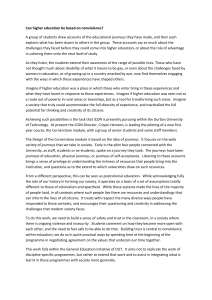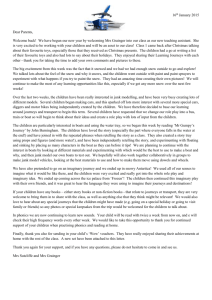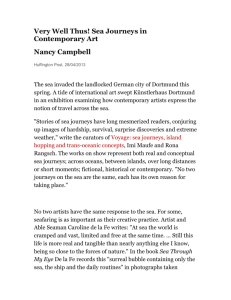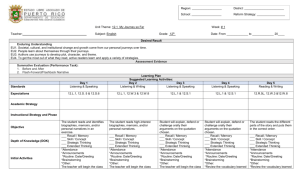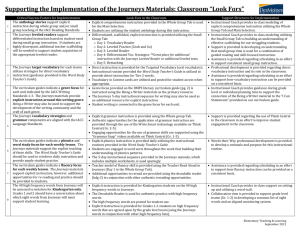London 2012 Travel Demand Management
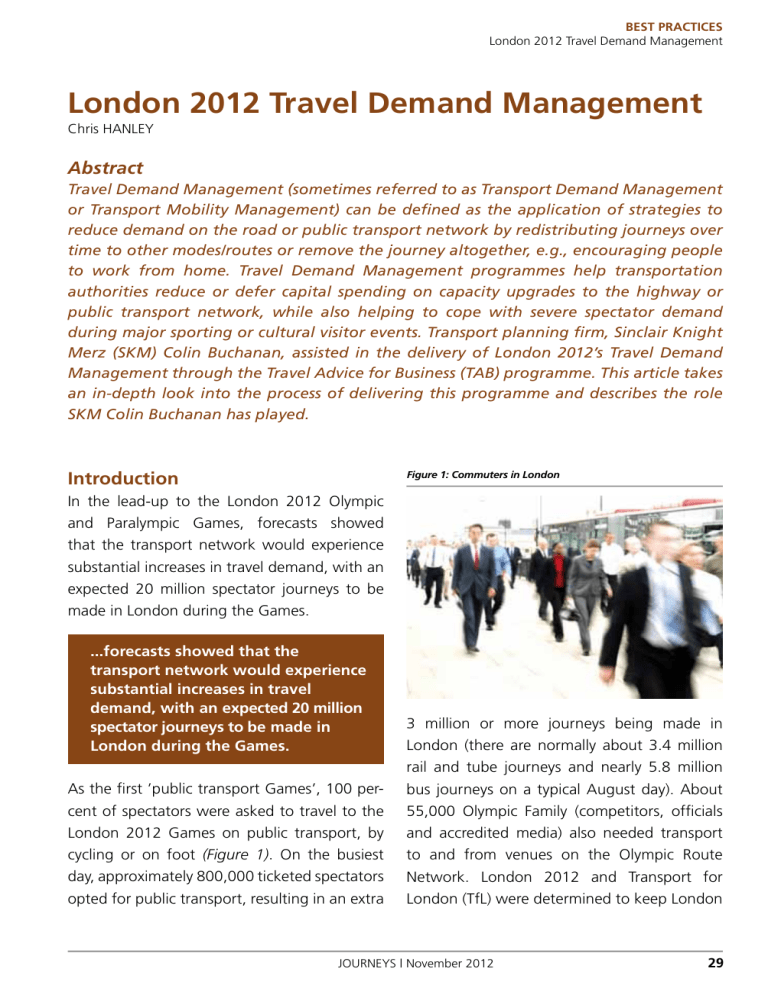
BEST PRACTICES
London 2012 Travel Demand Management
London 2012 Travel Demand Management
Chris HANLEY
Abstract
Travel Demand Management (sometimes referred to as Transport Demand Management or Transport Mobility Management) can be defined as the application of strategies to reduce demand on the road or public transport network by redistributing journeys over time to other modes/routes or remove the journey altogether, e.g., encouraging people to work from home. Travel Demand Management programmes help transportation authorities reduce or defer capital spending on capacity upgrades to the highway or public transport network, while also helping to cope with severe spectator demand during major sporting or cultural visitor events. Transport planning firm, Sinclair Knight
Merz (SKM) Colin Buchanan, assisted in the delivery of London 2012’s Travel Demand
Management through the Travel Advice for Business (TAB) programme. This article takes an in-depth look into the process of delivering this programme and describes the role
SKM Colin Buchanan has played.
Introduction
In the lead-up to the London 2012 Olympic and Paralympic Games, forecasts showed that the transport network would experience substantial increases in travel demand, with an expected 20 million spectator journeys to be made in London during the Games.
Figure 1: Commuters in London
...forecasts showed that the transport network would experience substantial increases in travel demand, with an expected 20 million spectator journeys to be made in
London during the Games.
As the first ’public transport Games’, 100 percent of spectators were asked to travel to the
London 2012 Games on public transport, by cycling or on foot (Figure 1) . On the busiest day, approximately 800,000 ticketed spectators opted for public transport, resulting in an extra
3 million or more journeys being made in
London (there are normally about 3.4 million rail and tube journeys and nearly 5.8 million bus journeys on a typical August day). About
55,000 Olympic Family (competitors, officials and accredited media) also needed transport to and from venues on the Olympic Route
Network. London 2012 and Transport for
London (TfL) were determined to keep London
JOURNEYS | November 2012 29
BEST PRACTICES
London 2012 Travel Demand Management
“open for business” throughout summer 2012
(Figure 2) . To ensure the delivery of a great
Olympic Games and to keep London moving,
London 2012 and TfL worked in partnership with businesses through the TAB programme.
The programme was also applied in Eton
Dorney and Weymouth.
Figure 2: Green Park Station, London Underground and assist in managing demand for transport.
SKM Colin Buchanan worked with TfL to deliver this programme and helped to advise businesses and stakeholders at every level to plan for travel disruptions during the Games.
This was an unprecedented challenge in terms of providing response to the expected disruptions across the network.
Detailed analysis showed that the transport challenge would be focused on certain times and in certain locations—primarily in central
London, around Games venues and on the
Olympic and Paralympic Route Network. The
Travel Demand Management programme encouraged individuals and businesses to change their travel plans, freight and delivery arrangements through greater understanding of the likely disruption to their journey. This large-scale behaviour change programme aimed to change travel behaviour of commuters and other business travellers, working with businesses to ensure they make practical preparations, to make the most of the Games
The TAB initiative was part of a wider programme that brought together a step change in travel behaviour during the
Games for spectators and the wider business community. The other key strands included:
• Travel Information Systems—a suite of online tools including the Spectator
Journey Planner and the Get Ahead of the
Games commuter tool.
• Freight Advice Programme—a targeted programme for large distribution companies, construction firms and lights goods vehicles to ensure they plan deliveries around the peak times of the
Games.
• Marketing and Communications—the branding and messaging behind the campaign, along with a range of materials, to support businesses.
Detailed analysis showed that the transport challenge would be focused on certain times and in certain locations...
Travel Advice for Business (TAB)
Programme
SKM Colin Buchanan’s contribution to London
2012’s TAB programme was to provide site-
30 JOURNEYS | November 2012
London Olympics, 2012
BEST PRACTICES
London 2012 Travel Demand Management
Source: Transport for London, London Assembly Transport Committee specific travel advisors to support key contacts within businesses to prepare London businesses for the London 2012 Olympic Games.
For businesses to access the TAB programme, they had to be located in the areas anticipated to suffer from the greatest highway and public transport congestion during the Games and have at least 200 staff. The programme was entirely free to join with business community events held prior the launch to encourage many businesses to sign up. The key benefit seen by organisations taking part was that it would help their business to function more effectively during the Games.
The key benefit seen by organisations taking part was that it would help their business to function more effectively during the Games.
JOURNEYS | November 2012 31
BEST PRACTICES
London 2012 Travel Demand Management
The TAB programme focused on businessrelated travel, covering travel to work, business trips and servicing and delivery. It targeted businesses within the high traffic areas of the West End, Westminster, Bank, the South
Bank from Waterloo to London Bridge, Canary
Wharf, Stratford and Canning Town, Liverpool
Street, King’s Cross St. Pancras, as well as the out-of-London Games locations of Weymouth and Portland, and Windsor and Eton.
reduce the impact on their business. They employed several steps to implement change.
Step 1 – Initiated an inception meeting with individual businesses from facilities managers to human resources and business continuity managers to gain senior management endorsement.
Step 2 – Advisors provided businesses with an overview of the transport challenges expected in London.
The TAB programme encouraged four principal responses:
• Reducing the need to travel
• Re-timing the journey
• Re-mode , primarily mode shift from public transport to walking and cycling
• Re-routing to less busy routes on the road and public transport network
Step 3 – Advisors collected information on the businesses and assessed the Games transport challenges and effects on all business operations such as existing sustainable travel initiatives and facilities, flexible or remote working policies, staff travel, business travel, visitor travel and deliveries and suppliers.
As of May 2012, more than 500 businesses across London, Eton Dorney and Weymouth, accounting for more than half a million employees, signed up for TAB sessions. The
TAB programme was available for a range of sectors including offices, professional, retail, health care, tourism and entertainment.
Step 4 – Established what home working/ remote working policies are in place and whether the businesses have alternative office locations that staff could use and if so, what capacity these options have.
The travel advisors worked closely with businesses to encourage senior management to instigate changes to working patterns, as well as providing travel information and advice to staff and suppliers, in order to
Step 5 – The final key area for the businesses to consider involved deliveries and servicing; are they able to stockpile goods, can deliveries be re-timed, and can deliveries be coordinated with neighbours? This also encouraged businesses to talk to their suppliers and persuade them to get ready for the Games.
...advisors worked closely with businesses to encourage senior management to instigate changes to working patterns, as well as providing travel information and advice to staff and suppliers...
For smaller businesses that were not eligible to take part in the programme, a series of workshops were offered to ensure the messages reached the widest audience possible. A TAB toolkit was developed called
‘Keep on Running’, which contained details of
32 JOURNEYS | November 2012
BEST PRACTICES
London 2012 Travel Demand Management the key measures businesses should consider during the Games.
facilities to do so and how often they usually worked from home.
A TAB toolkit was developed called
‘Keep on Running’, which contained details of the key measures businesses should consider during the Games.
Understanding Business Situations
Where appropriate, the advisors assisted businesses to carry out staff travel surveys to establish the staff’s travel characteristics. The surveys identified how staff travelled to work, time of travel and the mode used. For public transport users the surveys established the last station used, the underground lines used and the national rail stations used. This information helped the business understand where and how staff were travelling to work and assess if there were going to be issues during the
Games. The surveys also sought to understand if staff could work from home, if they had the
The survey results not only helped businesses to understand how staff could be impacted, but also how likely they would be to take action to avoid disruption during the Games.
This not only had implications for the Olympic and Paralympic Games periods, but also for businesses moving forward in terms of business continuity, and future planning of staff arrangements.
Results of the surveys are presented to businesses in a simple, easy to understand format, an example of which can be seen in
Figure 3.
Once staff characteristics were established, the site-specific travel advisors investigated the businesses travel initiatives, such as cycle parking, cycle to work schemes, showers/ locker facilities and parking and permits.
Figure 3: Staff likelihood to change behaviour to avoid disruption during the Games
Very Likely Likely Unsure Unlikely Very Unlikely
50
40
30
20
10
0
100
90
80
70
60
34%
19%
15%
19%
12%
I will work from home or at an alternative location
44%
23%
14%
13%
6%
I will take annual leave
38%
25%
20%
26%
17%
13%
30%
18%
6%
I will change my mode of transport I use for my journey to work
7%
I will change the time I make my journey to work by an hour or more
36%
30%
12%
17%
5%
I will change the route of my journey to work
JOURNEYS | November 2012 33
BEST PRACTICES
London 2012 Travel Demand Management
The survey results not only helped businesses to understand how staff could be impacted, but also how likely they would be to take action to avoid disruption during the Games. highlighting policies to be amended, facilities to be introduced, ways of raising awareness amongst staff, visitors, suppliers and clients, and business continuity procedures. Then finally testing; is everyone on-board, how will the business cope? The action plans are structured around the 4 Rs (Reduce, Re-time,
Re-mode and Re-route) and allocates tasks, responsibilities and sets timescales (Table 1).
Developing Action Plans
From the information collected, the travel advisors issued reports and action plans for the businesses. Each business received a
SWOT analysis from the advisors that clearly highlighted the Strengths, Weaknesses,
Opportunities and Threats to the organisation during Games time. This information was then fed into the action plan.
Each business received a SWOT analysis from the advisors that clearly highlighted the Strengths, Weaknesses,
Opportunities and Threats to the organisation during Games time.
The action plans set out clear steps which prepared individual businesses for the Games,
The site-specific advisors tailored the approach to suit each business individually. This allowed the organisation to have an approach that could be implemented during the Games,
Table 1: Some of the measures based on the 4 Rs
• Implement agile working strategy for home working—could IT systems cope, do staff have the right equipment?
• Introduce compressed working week strategy
• Introduce a managed approach to take annual leave
• Arrange for staff to work at alternative offices
• Reduce the need for business travel to and from the offices–provide tele/video conference facilities and publicise to staff
• Encourage staff to take annual leave over the Games and manage as necessary
• Stockpiling of non-perishable goods for Games time—is there sufficient available space?
• Coordination of servicing with neighbouring businesses
• Minimise the volume of personal mail/parcel delivered during congested times
• Encourage staff travelling to the office to re-time their journeys to avoid peak congestion—set up system for flexible working, make sure security and support function cope with out of hours working
• Ask staff to re-time client meetings and business trips to outside of the Games
• Manage supplies such that deliveries are arranged for times when the Games impact will be minimal
• Reduce impact on clients/visitors travelling to the business—provide information about transport hotspots and the alternatives
34 JOURNEYS | November 2012
BEST PRACTICES
London 2012 Travel Demand Management
• Provide essential staff with travel planning tools
• Promote walking to/from work—provide staff with access to walking maps and route planning
• Promote cycling to work and link messages with London 2012 health and fitness messages.
Promote cycling to work schemes and encourage staff to get prepared beforehand. Promote use of cycle hire bikes. Where required, expand facilities for cyclist, e.g., parking. Provide journey planning information and maps
• Use local suppliers and those that use alternative travel modes
• Promote using the bus instead of the tube, particularly for journeys beyond the central London area (where buses are less likely to be disrupted)
• Encourage staff to choose (and test) a new route to work to avoid worst delays by providing staff with relevant information of predicted hotspots and delays to reduce demand on the transport system, secure capacity for spectators, commuters and the wider travelling public, and to keep London
“open for business”.
The site-specific advisors tailored the approach to suit each business individually.
Avoiding and Relieving the Peak
Congestion on Public Transport
While reducing the need to travel and remoding journeys are more traditional travel plan actions, “re-time” and “re-route” are more innovative responses and we foresee these to be very applicable in Asian cities.
Figure 4 below, for example, shows London
Figure 4: AM and PM peaks of London Bridge Station
Time / Day
Saturday
28th Jul
Sunday
29th Jul
Monday
30th Jul
Tuesday
31st Jul
Wednesday
1st Aug
Thursday
2nd Aug
Friday
3rd Aug
7 - 7.30 am
7.30 - 8 am
8 - 8.30 am
8.30 - 9 am
9 - 9.30 am
9.30 - 10 am
10 - 10.30 am
10.30 - 11 am
11 - 11.30 am
11.30 am - 12 pm
12 - 12.30 pm
12.30 - 1 pm
1 - 1.30 pm
1.30 - 2 pm
2 - 2.30 pm
2.30 - 3 pm
3 - 3.30 pm
3.30 - 4 pm
4 - 4.30 pm
4.30 - 5 pm
5 - 5.30 pm
5.30 - 6 pm
6 - 6.30 pm
6 .30 - 7 pm
7 - 7.30 pm
7.30 - 8 pm
8 - 8.30 pm
8.30 - 9 pm
9 - 9.30 pm
9.30 - 10 pm
10 - 10.30 pm
10.30 - 11 pm
11 - 11.30 pm
11.30pm - 12am
12 - 12.30 am
12.30 - 1 am
May be busier than normal, but no additional wait time is predicted
Source: Get Ahead of the Games, London 2012
Saturday
4th Aug
Sunday
5th Aug
Up to 15 minutes wait to board a service
Monday
6th Aug
Tuesday
7th Aug
Wednesday
8th Aug
Thursday
9th Aug
Friday
10th Aug
Saturday
11th Aug
Sunday
12th Aug
15–30 minutes wait to board a service
Longer than 30 minutes wait to board a service
JOURNEYS | November 2012 35
BEST PRACTICES
London 2012 Travel Demand Management
Bridge Station across the Games and the importance that re-timing can have on relieving severe demand on the network during peak
AM and PM peaks.
The application of actions also varied by business type. Whilst encouraging flexible working and re-timing journeys were more popular among office based businesses with staff who did not have to work fixed shift patterns, re-routing and re-moding were more popular with service industries such as retail, leisure and healthcare.
Flexible working uptake also varied within an organisation, for example, in a bank, up to
60% of the workforce could work more flexibly but the remainder who were key traders and their support staff had very fixed shift patterns.
However, some banks allowed working from an alternative office location if homeworking or staggering working hours were not suitable.
Figure 5 : London’s double decker bus—Bus travel was actively encouraged for the Games
Travel Demand Management team in London
2012. The mantra of the project was “going to few to reach many”, which utilised building relationships with business intermediaries representing different business size, sector and geographies. The focus of the relationship was to enable London 2012 to engage with the right audience and then feed these channels with the appropriate travel behaviour change message which ended up in Travel Demand
Management gaining access to communication channels that distributed a message to over
204,000 businesses across London.
Away from the Olympic Route Network in outer London areas, bus travel (Figure 5) was actively encouraged and popular with employees as most visitors to the Games used the tube, trains and Docklands Light Railway
(DLR) as their preferred method of transport.
...bus travel (Figure 5) was actively encouraged and popular with employees as most visitors to the
Games used the tube, trains and DLR as their preferred method of transport.
Business Stakeholder Engagement
Programme
SKM Colin Buchanan also developed and delivered a far-reaching business stakeholder engagement programme on behalf of the
Members of the team were also involved in workshops for small and medium enterprises and large multi-site companies, to help them assess the potential impact of the Games on staff, business and freight travel and to develop
Action Plans to guide the implementation of measures across their business. Workshops were specifically targeted at delegates with a strategic overview of their organisation and provide businesses with an understanding of the measures each business can take to mitigate the impacts of the Games and the tools available to make changes across the business and communicate the challenges to staff, clients, visitors and suppliers.
36 JOURNEYS | November 2012
BEST PRACTICES
London 2012 Travel Demand Management
So how did London do during the
Games?
Overall, early results show London coped very well with the transport challenges even though
TfL experienced record ridership across their transport networks. London Underground, for example, carried 4.52 million passengers on
Thursday, 9 August—the highest number of passengers in its 149-year history. On Friday,
3 August, the DLR carried over half a million passengers for the first time, up 70 per cent on usual levels. Barclays Cycle Hire also broke records with 1 million hires in July.
London Underground, for example, carried 4.52 million passengers on Thursday, 9 August
—the highest number of passengers in its 149-year history.
...success is attributed to the role that employers have played in encouraging and enabling staff, suppliers and visitors to be flexible in their travel so as to avoid using transport in the busiest places at the busiest times.
The Travel Demand Management TAB
Programme provided assistance for businesses in planning and acting to prepare them for the Games.
The programme met its core objective in assisting London to deliver a great Olympic and Paralympic Games and to keep London moving, ensuring the city remained ‘open for business’ with no adverse impact on productivity. The programme involved gaining great understanding of business needs and operations across a range of sectors and means to persuade senior managers to implement significant changes to their business operations.
All athletes, officials, spectators and the world’s media arrived at their events in good time. This success is attributed to the role that employers have played in encouraging and enabling staff, suppliers and visitors to be flexible in their travel so as to avoid using transport in the busiest places at the busiest times. At key stations, in the West End and at Canary Wharf for example, London saw the same or greater numbers of people, just spread out over a longer time period in the morning and evening peaks.
The added value for London, Eton Dorney and
Weymouth participating organisations was the development of an Action Plan to guide the implementation of policies and marketing messages to influence travel behaviour in the long-term. The programme also had positive implications for the legacy of the Games, as businesses considered more sustainable future operations.
Conclusion
As anticipated, the London 2012 Olympic
Games placed an unprecedented demand on the transport network with 20 million extra trips being made within London during the Games.
The programme involved gaining great understanding of business needs and operations across a range of sectors and means to persuade senior managers to implement significant changes to their business operations.
JOURNEYS | November 2012 37
BEST PRACTICES
London 2012 Travel Demand Management
Chris Hanley heads the Sustainable Transport team in the Sinclair Knight
Merz (SKM), London office. He was appointed to the Olympic Delivery
Authority’s Business Advisory Panel last year to support the Travel Demand
Management aspects of the Games. As such he worked with over 30 businesses from a range of sectors, including financial services, retail, leisure and healthcare. He has also managed behavioural change and travel planning projects for a range of high profile private sector clients, including American Airlines, Grosvenor Properties and Coca-Cola. He has also helped to pioneer the development of business travel networks in Sutton and Kingston for
TfL. He is also often asked to provide technical support to Universities, NHS Trusts and private businesses on the development of parking strategies to support travel demand management initiatives. Previously, Chris worked for the NHS and for Peterborough City Council, supporting their Travel choice programme which has seen significant area wide modal shift and carbon reduction.
38 JOURNEYS | November 2012
